| Pages:
1
2
3
4
5
..
10 |
j_sum1
Administrator
       
Posts: 6218
Registered: 4-10-2014
Location: Unmoved
Member Is Offline
Mood: Organised
|
|
woot! I wil look that up when I get a chance. But it does sound more complex than burnt toast.
|
|
|
Morgan
International Hazard
    
Posts: 1660
Registered: 28-12-2010
Member Is Offline
Mood: No Mood
|
|
Quote: Originally posted by j_sum1  | Let me throw out another possibility for this process. Suppose you pre-soaked your bread in a solution of Pt salts. Might you then get a catalytic
product with a really high surface area? It could be rather useful.
(Now, it would be nice if this brought the Ostwald process within the range of home chemists but with the oxidising conditions the supertoast™ won't
survive.)
[/random ramblings] |
If you could platinize and char a slice of bread, how amusing it might be to lower the whole piece into a vessel filled with methanol vapor to behold
catalytic glowing toast.
|
|
|
Texium
Administrator
       
Posts: 4508
Registered: 11-1-2014
Location: Salt Lake City
Member Is Offline
Mood: PhD candidate!
|
|
Quote: Originally posted by j_sum1  | Let me throw out another possibility for this process. Suppose you pre-soaked your bread in a solution of Pt salts. Might you then get a catalytic
product with a really high surface area? It could be rather useful.
(Now, it would be nice if this brought the Ostwald process within the range of home chemists but with the oxidising conditions the supertoast™ won't
survive.)
[/random ramblings] |
Maybe not for the Ostwald process, but that could possibly be a good, easy way to
generate palladium or platinum on carbon catalyst for hydrogenations!
|
|
|
metalresearcher
National Hazard
   
Posts: 731
Registered: 7-9-2010
Member Is Offline
Mood: Reactive
|
|
I took the 'bread char' out of the cooled wood stove.
The 'bread char' is very fragile. It breaks easily apart.
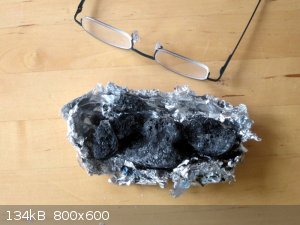
|
|
|
aga
Forum Drunkard
    
Posts: 7030
Registered: 25-3-2014
Member Is Offline
|
|
Action ! Woohoo !
I guess the next step will be to make bread with Other ingredients added and see if we can :-
a) get some kind of regular shape
b) make it into something useful
Electrodes and/or catalysts sounds promising.
|
|
|
Morgan
International Hazard
    
Posts: 1660
Registered: 28-12-2010
Member Is Offline
Mood: No Mood
|
|
Seems like a very fine grain bread would make a stronger carbon foam, a dense bread with smaller pores. You see platinum on alumina and platinum on
carbon, but does it have any benefit to make a carbon/alumina combination? Or maybe add alumina or aluminum hydroxide to the bread mix hopefully as a
binding agent to strengthen the friable carbon foam.
Yesterday I came across this noodle matrix technique and wondered if a fine noodly lattice could be baked into a carbon fiber cross-linked morass of
some sort.
2,4,8,16,32,64,128, 256 I've seen a baker get to 1024.
https://www.youtube.com/watch?v=RCWfAhuUaU8#t=23
https://www.youtube.com/watch?v=L54-cInHrg0
A sugar approach
https://www.youtube.com/watch?v=euaEvOdk2Sg
A good presentation with countdown
https://www.youtube.com/watch?v=odL8JdQpMs4
Maybe baking bread under pressure in a hydrothermal synthesis vessel would be of some benefit or a useful pretreatment method.
[Edited on 4-11-2016 by Morgan]
|
|
|
Maroboduus
Hazard to Others
  
Posts: 257
Registered: 14-9-2016
Location: 26 Ancho Street
Member Is Offline
Mood: vacant
|
|
Morgan's thoughts on pore size make a lot of sense from a structural point of view.
But there is the question of whether gluten development affects the final product as well.
The more a dough is worked, the more the gluten is 'developed', leading to cross links which make a more resilient bread. Sort of like denaturing egg
whites when you cook them.
I have no idea if these cross links would change the nature of the final product after the oven treatment, but it seems possible that this could lead
to greater bonding strength because although these cross links are wiped out in the carbonization, they may hold the molecules in more intimate
contact long enough to encourage other cross linking to form as the product carbonizes.
It's difficult to judge baked goods from photos, but it appears that aga's sample may be a fairly robust material with well developed gluten to give
it substance in spite of it's large pores. This contrasts sharply with the common sliced breads with a softer texture (for readers from the US, think
Wonder Bread, or Kilpatrick's white sandwich bread, in Mexico, Bimbo's sliced sandwich bread is similar)
This difference may have some influence on the strength of the final product.
It might be helpful if those reporting results included what information they can about the texture, pore size, chewiness; and of course for mass
produced breads, the brand.
Maybe all breads work well, but if variable results are reported this may be part of the answer.
Of course the nature of the conditions of carbonization is no doubt more important. getting that right is obviously critical.
|
|
|
ficolas
Hazard to Others
  
Posts: 146
Registered: 14-5-2016
Member Is Offline
Mood: No Mood
|
|
What about adding small metallic (copper for easyness and cheapyness, platinum for goodness) particles to try to increase conductivity, and then if
the copper doped bread char is conductive enough, attempt to electroplate it with metal?
Could that work?
|
|
|
aga
Forum Drunkard
    
Posts: 7030
Registered: 25-3-2014
Member Is Offline
|
|
'Bimbo' must be a Hispanic bread brand, 'cos i can get that here and will do so tomorrow.
| Quote: | | like denaturing egg whites when you cook them |
Meringue !
That's also full of bubbles (adds eggs and caster sugar to shopping list)
Lo ! I forsee Fire. Lots of Fire, with bits in it, carbonising.
|
|
|
violet sin
International Hazard
    
Posts: 1475
Registered: 2-9-2012
Location: Daydreaming of uraninite...
Member Is Offline
Mood: Good
|
|
My attempt last night failed, burn through. Impatients placed it too close to the really hot area. Also bread on hand was seedy. So today gonna hit
the stores up and get more prefered materials. I want to do sourdough because of large pores. Should be better for depositing Ni with out closing
out as much interior surface. Thinking dollar store for a thicker Al pie pan/turkey tray or the like to enclose around standard foil wrapped bread.
Charcoal also instead of the wood stove should provide more controll, maybe a meal to boot. Check back in when something works out.
|
|
|
aga
Forum Drunkard
    
Posts: 7030
Registered: 25-3-2014
Member Is Offline
|
|
If at first you don't succeed ...
We now have two photos of an experiment with a result at the end, so it can definitely be done.
I got lucky by trying two types of bread at the same time.
If i'd just used the brown bread, there'd be nothing much to see.
White Wonder Bread seems to be the #1 choice.
|
|
|
Jstuyfzand
Hazard to Others
  
Posts: 166
Registered: 16-1-2016
Location: Netherlands
Member Is Offline
Mood: Learning, Sorta.
|
|
Quote: Originally posted by aga  | If at first you don't succeed ...
We now have two photos of an experiment with a result at the end, so it can definitely be done.
I got lucky by trying two types of bread at the same time.
If i'd just used the brown bread, there'd be nothing much to see.
White Wonder Bread seems to be the #1 choice. |
AvE used the white wonder bread too, worked very well for him too.
It even resisted a oxy-acetylene torch, with a temperature probe behind a 2 cm slab of bread, it only reached 80C.
This stuff has potential.
I am finishing my 1000C kiln soon, I will try to put a large piece of bread in it too see how it performs as a brick.
|
|
|
battoussai114
Hazard to Others
  
Posts: 235
Registered: 18-2-2015
Member Is Offline
Mood: Not bad.... Not bad.
|
|
Bimbo is indeed a Mexican brand, but they're actually present in the Americas and also Europe (and they own the brand that makes Twinkies too).
Sounds like a decent option to standardize tests from members.
Batoussai.
|
|
|
careysub
International Hazard
    
Posts: 1339
Registered: 4-8-2014
Location: Coastal Sage Scrub Biome
Member Is Offline
Mood: Lowest quantum state
|
|
Quote: Originally posted by Maroboduus  | Morgan's thoughts on pore size make a lot of sense from a structural point of view.
But there is the question of whether gluten development affects the final product as well.
The more a dough is worked, the more the gluten is 'developed', leading to cross links which make a more resilient bread. Sort of like denaturing egg
whites when you cook them.
I have no idea if these cross links would change the nature of the final product after the oven treatment, but it seems possible that this could lead
to greater bonding strength because although these cross links are wiped out in the carbonization, they may hold the molecules in more intimate
contact long enough to encourage other cross linking to form as the product carbonizes.
|
Gluten development is essential for establishing the pore structure of yeast-risen bread. You cannot use baker's yeast to leaven rye bread that has
low gluten. The physical structure of the bread prior to pyrolyzing must affect the final structure.
About that which we cannot speak, we must remain silent.
-Wittgenstein
Some things can never be spoken
Some things cannot be pronounced
That word does not exist in any language
It will never be uttered by a human mouth
- The Talking Heads
|
|
|
violet sin
International Hazard
    
Posts: 1475
Registered: 2-9-2012
Location: Daydreaming of uraninite...
Member Is Offline
Mood: Good
|
|
Got it to work. Took more care and a few bucks, $4.50. But a plastic insert stainles steel coffee cup from the thrift store was stripped to just the
stainless shell. Safeway bakery -european french bread, cut to size, wrapped in dollar store Al foil and ends twisted, put in ss cup shell, Al foil
over top, aluminum cat food can( free) covering top but fits just inside the ss shell, then the top covered in a couple pieces of foil. Put in wood
stove used for heating a home. 1/2 hr leaning on few coals- rotated on 15 min, another 1/2 hr in warmer parts, repeat for a total of 2.5hr with final
half hour cup glowing red on one side in a the hottest part of coals.
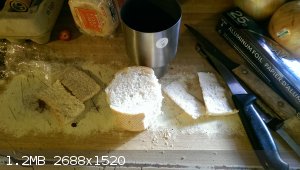 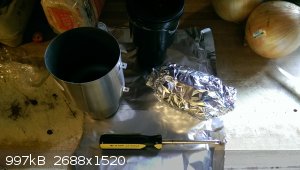
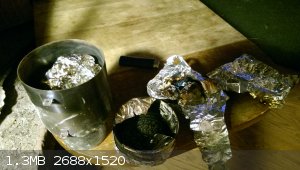 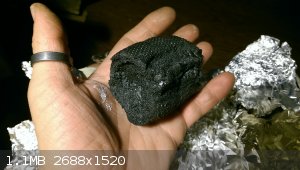
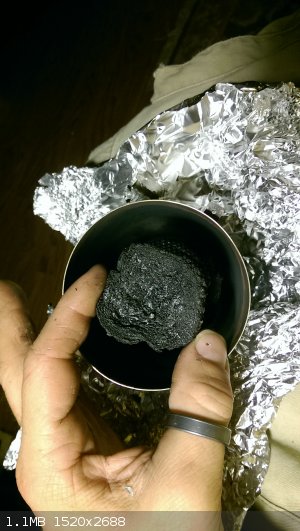
It now clinks when jarred and feels sturdy. Tomorrow I'll cut it up a bit to hopefully make some test squares. Try some soak in and reheat additives
to increase conductivity or something. Hate to set up Ni bath and clean it up if there isnt enough conductivity to strike something on. Well, there
ya go, did some toast burning. No scale to calculate loss on charring.
|
|
|
aga
Forum Drunkard
    
Posts: 7030
Registered: 25-3-2014
Member Is Offline
|
|
Superb !
I think that is the largest single chunk anyone has made so far.
|
|
|
Morgan
International Hazard
    
Posts: 1660
Registered: 28-12-2010
Member Is Offline
Mood: No Mood
|
|
Tidbits and free associations
Maybe the structural strength could be improved by adding some chopped carbon fiber sans resin to a bread mix.
Another approach might be to try building up the strength of a carbon foam shape by dipping it in a liquid bread dough and do consecutive baking,
adding layer upon layer, if perchance that was adventitious.
I'd like to see a carbon foam that would be airtight and lightweight in the form of a tube able to handle HIGH temperatures and most of all low cost.
It wouldn't have to be very strong, but just enough to build parts for a myriad of toys and MAKE projects. Lots and lots of science projects would
then be available, from toy boats to model airplanes, or structures that are uniquely offered by these qualities. Delicate toast heat engines would be
fun to design, a toast to the materials science of toast.
Offhand what might be the coefficient of thermal expansion of "Wonder Bread" foam?
This stuff is heavy and costly and only good for non-combustion projects.
"These high temperature sheets maintain most of their rigidity up to 500 F, and can withstand short durations at much higher temperatures."
https://www.youtube.com/watch?v=l1Rt2dhlJB4
https://dragonplate.com/ecart/categories.asp?cID=189
|
|
|
j_sum1
Administrator
       
Posts: 6218
Registered: 4-10-2014
Location: Unmoved
Member Is Offline
Mood: Organised
|
|
| Quote: | | I'd like to see a carbon foam that would be airtight <snip> |
I think this is a contradiction -- unless you can somehow force a closed-cell foam. This probably excludes a bread structure.
|
|
|
unionised
International Hazard
    
Posts: 5102
Registered: 1-11-2003
Location: UK
Member Is Offline
Mood: No Mood
|
|
Interesting topic.
It reminds me of my failed attempt to make a sponge from aluminium phosphate.
I dissolved AlPO4 in citric acid solution and soaked a cellulose sponge in it then let it dry and finally tried to burn off everything but the AlPO4.
I was hoping to get a thermal and electrical insulator but what I got was black which I took to mean that it was full of carbon. It wasn't a good
enough electrical insulator for my purposes and I couldn't get the carbon to burn off properly.
Just a quick question for those who have spent some time pyrolysing bread to carbon foam:
What happens if you microwave the foam?
|
|
|
aga
Forum Drunkard
    
Posts: 7030
Registered: 25-3-2014
Member Is Offline
|
|
Er, dunno, not tried that - yet.
1 sec.
Edit:
Woot woot !
It gets all jiggy like an electric arc furnace and really annoys the wife !
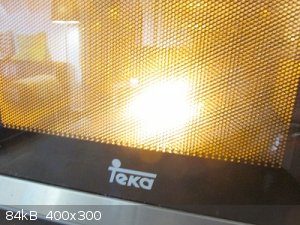
It also makes a bzzzzt-bzzzzt noise, exactly like an electric arc.
I noticed some bits of Al foil still stuck to it, so broke off a smaller piece with no foil, and tried again.
It did the same thing.
[Edited on 5-11-2016 by aga]
|
|
|
wg48
National Hazard
   
Posts: 821
Registered: 21-11-2015
Member Is Offline
Mood: No Mood
|
|
Quote: Originally posted by unionised  | Interesting topic.
It reminds me of my failed attempt to make a sponge from aluminium phosphate.
I dissolved AlPO4 in citric acid solution and soaked a cellulose sponge in it then let it dry and finally tried to burn off everything but the AlPO4.
I was hoping to get a thermal and electrical insulator but what I got was black which I took to mean that it was full of carbon. It wasn't a good
enough electrical insulator for my purposes and I couldn't get the carbon to burn off properly.
Just a quick question for those who have spent some time pyrolysing bread to carbon foam:
What happens if you microwave the foam?
|
How much AlPO4 does citric acid disssolve?
Wiki says AlPO4 melts at 1800C so a solution of it may make a great refectory binder or a flux.
I would like to know what happens to microwaved carbonised toast too. I suspect it will heat up and burn.
|
|
|
aga
Forum Drunkard
    
Posts: 7030
Registered: 25-3-2014
Member Is Offline
|
|
Wait a sec.
If it's absorbing the microwaves, generating eddy currents in the carbon, and then arcing, it'd be like a super-susceptor.
The only susceptor i know of (magnetite) transforms the microwave to heat by basically getting hot.
This stuff bangs electric arc plasma next to what you're heating !
|
|
|
Morgan
International Hazard
    
Posts: 1660
Registered: 28-12-2010
Member Is Offline
Mood: No Mood
|
|
Quote: Originally posted by j_sum1  | | Quote: | | I'd like to see a carbon foam that would be airtight <snip> |
I think this is a contradiction -- unless you can somehow force a closed-cell foam. This probably excludes a bread structure. |
I wouldn't have any objection to coating the carbon toast foam with some sort of refractory sealant if that would work.
Here's some comments from this video clip. I don't see why you necessarily have to use bread to make a carbon foam though. Do traces of protein in the
bread help at all and if so maybe something as ridiculous as hagfish slime could be used in the dough.
http://www.iflscience.com/plants-and-animals/hagfish-slime-b...
Cotton fabrics are crisscrossed just as that dough clip I posted where they lay the strands atop each other perpendicular to ones below. Or maybe
carbonized worms could be used to build tube structures. I was thinking a carbonized wasp nest or honeycomb beehive would be interesting maybe again
coated with a high temperature glaze to shore up the fragile nature of the carbonized structure if possible.
http://oddstuffmagazine.com/mildly-interesting-things-this-o...
"Essentially that's what it was, they would cut 1 inch squares of cotton fabric like as if you cut up a white tshirt into perfect square pieces, took
a handful and soaked in epoxy resin of some kind or phenolic resin and then let it cure under tremendous pressure into this plastic molded shape of
resin impregnated cotton squares , they would then bake and burn off that resin leaving behind what they named carbon carbon which is the forerunner
to heat abatement tiles like on the space shuttle or at least that's how he described the process in layman's terms to me. hell of a interesting
engineer this guy, it was a pleasure to pick his brain"
https://www.youtube.com/watch?v=Wex_yKfrTo4
In the above clip it's curious why the foam doesn't conduct electricity.
"The creation of stiff yet multifunctional three-dimensional porous carbon architecture at very low cost is still challenging. In this work,
lightweight and stiff carbon foam (CF) with adjustable pore structure was prepared by using flour as the basic element via a simple fermentation and
carbonization process."
http://pubs.acs.org/doi/abs/10.1021/acsami.6b03985?journalCo...
[Edited on 5-11-2016 by Morgan]
|
|
|
ficolas
Hazard to Others
  
Posts: 146
Registered: 14-5-2016
Member Is Offline
Mood: No Mood
|
|
Quote: Originally posted by aga  | Wait a sec.
If it's absorbing the microwaves, generating eddy currents in the carbon, and then arcing, it'd be like a super-susceptor.
The only susceptor i know of (magnetite) transforms the microwave to heat by basically getting hot.
This stuff bangs electric arc plasma next to what you're heating ! |
Dunno about that but what you described looked like when I microwaved a pencil. It arc-ed, made bzzzb bzzz sounds
It also really annoyed my female room mate, the male one seemed to enjoy it tho. Maybe it has some female-annoying properties.
|
|
|
TheAlchemistPirate
Hazard to Others
  
Posts: 151
Registered: 25-3-2014
Location: The point of no return
Member Is Offline
Mood: Enigmatic
|
|
Interesting. I microwaved my carbon foam the other day without anything happening at all, even after trying to preheat it with a flame. I have done
experiments with carbonized bamboo skewers in close proximity, which arc in interesting ways when preheated. My guess is that my carbon foam was not
"cooked" enough, and that there is a large amount of charcoal in it compared to the lesser amount of conductive forms of carbon like graphite. I shall
try and see...
I did torch the carbon toast from earlier, for about a minute. The piece itself stayed intact, but I observed some cracks on the surface when
exposed directly to the flame.
Currently I am making my own dough, in an attempt to "cast" this carbon foam refractory in the shape of a crucible. I will update on this shortly.
"Is this even science anymore?!"
|
|
|
| Pages:
1
2
3
4
5
..
10 |